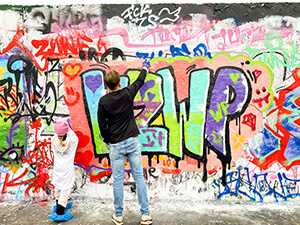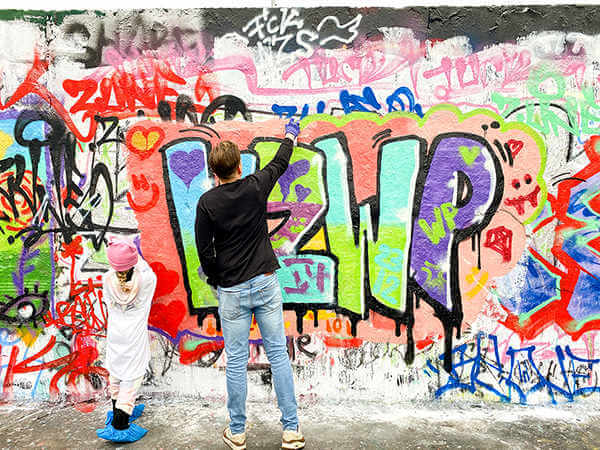The Impact of Graffiti on Urban Spaces
- News
-
Jan 10
- Share post


Graffiti, often considered a rebellious form of expression, has transcended its countercultural origins to become an integral part of the urban landscape. The vibrant strokes of spray paint, the intricate designs, and the bold statements contribute to the unique character of city streets worldwide. In this exploration, we delve into how graffiti adds a dynamic layer to urban environments, shaping the very essence of public spaces.
Unleashing Vibrancy Through Urban Canvases
One cannot wander through the streets of Berlin without being captivated by the explosion of colors and shapes adorning building facades. Graffiti, in its many forms, transforms mundane structures into dynamic canvases that tell stories, share perspectives, and evoke emotions. The juxtaposition of vibrant hues against the concrete backdrop injects life into the urban sprawl, turning the city into a sprawling outdoor gallery.
The act of spray-painting these urban canvases is not merely an act of rebellion; it is a declaration of existence, a way for artists to leave an indelible mark on the cityscape. From the politically charged murals to the abstract expressions of emotion, each piece of graffiti adds a layer of complexity to the city’s visual identity.
Street Art as a Catalyst for Cultural Expression
Beyond its aesthetic contribution, graffiti plays a pivotal role in shaping the cultural narrative of a city. It serves as a reflection of the community’s identity, offering a glimpse into its history, values, and aspirations. In Berlin, a city with a rich tapestry of stories, graffiti becomes a language that communicates the pulse of the people.
Street art, as a form of cultural expression, transcends linguistic barriers. It invites dialogue and fosters a sense of community, as artists communicate with residents and visitors alike. The open-air nature of graffiti transforms the city into a communal art gallery, where every passerby becomes a participant in the ongoing narrative of urban life.
Explore our graffiti workshop in Berlin to witness firsthand the intersection of art and culture in the heart of this dynamic city.
Shaping Public Spaces and Community Interaction
Graffiti is not confined to the realms of art galleries; it spills onto the streets, bridges, and alleyways, blurring the lines between formal art spaces and the everyday urban environment. In doing so, it challenges traditional notions of where art belongs and who gets to engage with it.
Public spaces, once sterile and uniform, now bear the imprint of individual and collective expressions. Graffiti transforms the mundane into the extraordinary, inviting residents and visitors to engage with their surroundings actively. This participatory element fosters a sense of ownership and pride among the community, as the city becomes a canvas for collective creativity.
As we navigate the urban spaces, we find ourselves immersed in a dialogue between the past, present, and future—a dialogue painted in the vibrant strokes of graffiti.
Navigating the Historical Tapestry of Graffiti
Graffiti, with its roots in ancient civilizations, carries a historical weight that adds depth to its contemporary manifestations. From the cave paintings of Lascaux to the political murals in Belfast, the act of leaving one’s mark on walls has been a constant thread in the human narrative.
In modern urban settings, graffiti serves as a visual time capsule, capturing the spirit of an era and preserving it for future generations. The layers of graffiti on a city wall represent not only the present but also the echoes of the past, creating a dialogue between different periods in history.
Berlin, a city marked by its own historical struggles and triumphs, exemplifies this intertwining of the old and the new. Graffiti here is not just an artistic expression; it’s a continuation of a tradition that spans centuries, a testament to the ever-evolving nature of human communication.
The Intersection of Graffiti and Architecture
One cannot discuss the impact of graffiti on urban spaces without acknowledging its intricate dance with architecture. Graffiti artists often use the built environment as a canvas, working with the contours of buildings to create three-dimensional masterpieces.
The relationship between graffiti and architecture is symbiotic. The rigid lines of a building facade provide a framework for the fluidity of spray-painted strokes, resulting in a harmonious blend of the organic and the structured. This interplay challenges conventional notions of how we perceive and interact with the structures that surround us.
The very act of transforming a static building into a dynamic work of art alters our perception of space. What was once a nondescript wall becomes a focal point, inviting individuals to pause, appreciate, and contemplate the symbiosis between human creativity and the built environment.
Visit our graffiti workshop to witness firsthand the fusion of graffiti and architecture, and discover how these elements converge to redefine urban landscapes.
Graffiti as a Catalyst for Social Change
While graffiti is often associated with rebellion and counterculture, it also serves as a powerful tool for social change. In many instances, artists use their craft to raise awareness about social issues, challenge established norms, and amplify marginalized voices.
Berlin, with its tumultuous history, has become a canvas for socio-political commentary through graffiti. Murals addressing topics such as migration, inequality, and environmental concerns dot the cityscape, sparking conversations that extend beyond the confines of art galleries.
Graffiti, in this context, becomes a form of visual activism—a way for artists to engage with the public and provoke thought. The transient nature of outdoor art means that these messages are in constant dialogue with the evolving social landscape, adapting and responding to the changing tides of public opinion.
Graffiti Tourism: A Fusion of Local and Global Perspectives
The global appeal of graffiti has turned cities like Berlin into hotspots for graffiti enthusiast tourism. Visitors from around the world flock to experience the dynamic street art scene, turning the act of exploring graffiti-laden neighborhoods into a form of cultural exchange.
Graffiti workshops, like the one we offer in Berlin, become hubs for this cultural fusion. Participants not only learn the techniques of graffiti but also gain insights into the local narratives and global conversations that shape the city’s artistic identity, from experienced and passionate street artists.
Join our graffiti workshop in Berlin to become a part of this vibrant exchange between local and global perspectives, and paint your own graffiti on the Berlin Wall with us 🙂
Preserving the Impermanence of Graffiti
One of the paradoxes of graffiti lies in its ephemeral nature. What is a vibrant mural today may be painted over or weathered away tomorrow. This impermanence, however, is a crucial aspect of graffiti’s impact on urban spaces.
The transient nature of outdoor art challenges traditional notions of permanence in the art world. It’s a reminder that creativity is a fluid and ever-changing force, mirroring the constant evolution of the cities it adorns. As layers of graffiti accumulate, the city itself becomes a living canvas, a testament to the impermanence and adaptability inherent in artistic expression.
Conclusion: A Tapestry of Expression in Urban Spaces
In conclusion, the impact of graffiti on urban spaces is a multifaceted tapestry of expression, culture, and activism. From its roots in ancient history to its contemporary role in shaping the dialogue of modern cities, graffiti continues to redefine the boundaries of art and public spaces.
As we navigate the streets of Berlin, we witness not just the strokes of spray paint but a living, breathing dialogue between artists, communities, and the city itself. Graffiti is more than an act of rebellion; it’s a celebration of creativity, a catalyst for cultural expression, and a powerful force for change.
Explore the intersection of art and urban spaces by joining our graffiti workshop in Berlin. Immerse yourself in the vibrant world of street art and become a part of the ever-evolving narrative of this dynamic city.